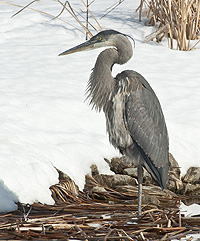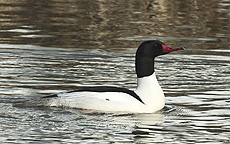Fermilab scouts feathered fliers over the holidays
 |
The great blue heron is a year-round resident of Fermilab. It is one of the birds sighted at the recent Christmas bird count at Fermilab. Photo: Dave Spleha
|
Every December the National Audubon Society, a nonprofit environmental organization focused on conservation, organizes a national bird census. Thousands of volunteers from across the country come together in small groups for a long day of looking and listening to deduce just how many birds and species of birds are in their area for the holidays.
Since 1976, Fermilab has hosted groups for the event, known as the annual Christmas bird count. Some teams, which consist of both avian experts and nonexperts, begin counting as early as 4:15 in the morning and continue until sunset. During that time they cover a circle that is 15 miles in diameter and expands to areas both on and around Fermilab grounds.
"It's always exciting because you never know what's going to turn up each year," said Peter Kasper, a physicist at Fermilab who's been part of the laboratory's bird counting club since 1988 and who also maintains the Birds of Fermilab website.
Despite the cold, wind and rain, many people turned out for last month's event, Kasper said. One of the main challenges for participants is to avoid counting the same bird multiple times. To do this, Kasper and the other volunteers stick to a strict schedule and path, covering as much area as possible.
One of this year's exciting finds for Fermilab counters was sighting a northern goshawk—a bird of prey with distinctive bars of white and black feathers across its front, which had remained unseen on Fermilab grounds for the last few years. Participants identified 53 different species for this year's count, which is an impressively high number, said Dave Spleha, who is active in monitoring the Fermilab bird population. The record high for the Christmas bird count at Fermilab is 55 species.
Unlike the northern goshawk, some species are becoming more prevalent at the laboratory with each passing decade. For example, the number of great blue herons at Fermilab steadily increased over the 1990s and remains ten times higher today than it was throughout the 1980s.
While this number could be due to an increase in population, the more likely explanation is changes in seasonal distributions, Kasper said. Many bird species, including the great blue heron, migrate south for the winter, but average winter temperatures are on the rise, leading to a reflective rise in bird numbers at higher latitudes.
Warmer climate is one of many factors that affects the results of the annual bird count. Other species, particularly the ring-necked pheasants, have declined over the years due to an increase in local coyote populations. Also, the West Nile virus greatly diminished American crow populations in 2002 when it reached Illinois.
In total, the laboratory has documented 285 bird species on its grounds. None of these include a festive partridge in a pear tree, however, since partridges are not native to the Americas. Instead, Kasper said he looks forward to sighting northern goshawks and barred owls in the coming years.
—Jessica Orwig
 |
The common merganser and other ducks are typical winter visitors in Fermilab's open waters. Photo: Dave Spleha |
|